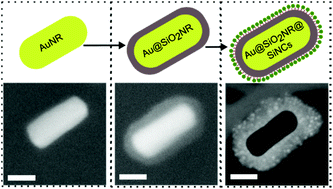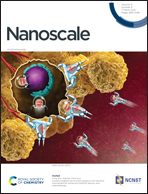Optimizing plasmon enhanced luminescence in silicon nanocrystals by gold nanorods†
Abstract
The great application potential of photoluminescent silicon nanocrystals, especially in biomedicine, is significantly reduced due to their limited radiative rate. One of the possible ways to overcome this limitation is enhancing the luminescence by localized plasmons of metallic nanostructures. We report an optimized fabrication of gold nanorod – silicon nanocrystal core–shell nanoparticles with the silica shell as a tunable spacer. The unprecedented structural quality and homogeneity of our hybrid nanoparticles allows for detailed analysis of their luminescence. A strong correlation between dark field scattering and luminescence spectra is shown on a single particle level, indicating a dominant role of the longitudinal plasmonic band in luminescence enhancement. The spacer thickness dependence of photoluminescence intensity enhancement is investigated using a combination of experimental measurements and numerical simulations. An optimal separation distance of 5 nm is found, yielding a 7.2× enhancement of the luminescence intensity. This result is mainly attributed to an increased quantum yield resulting from the Purcell enhanced radiative rate in the nanocrystals. The ease of fabrication, low cost, long-term stability and great emission properties of the hybrid nanoparticles make them a great candidate for bio-imaging or even targeted cancer treatment.



 Please wait while we load your content...
Please wait while we load your content...